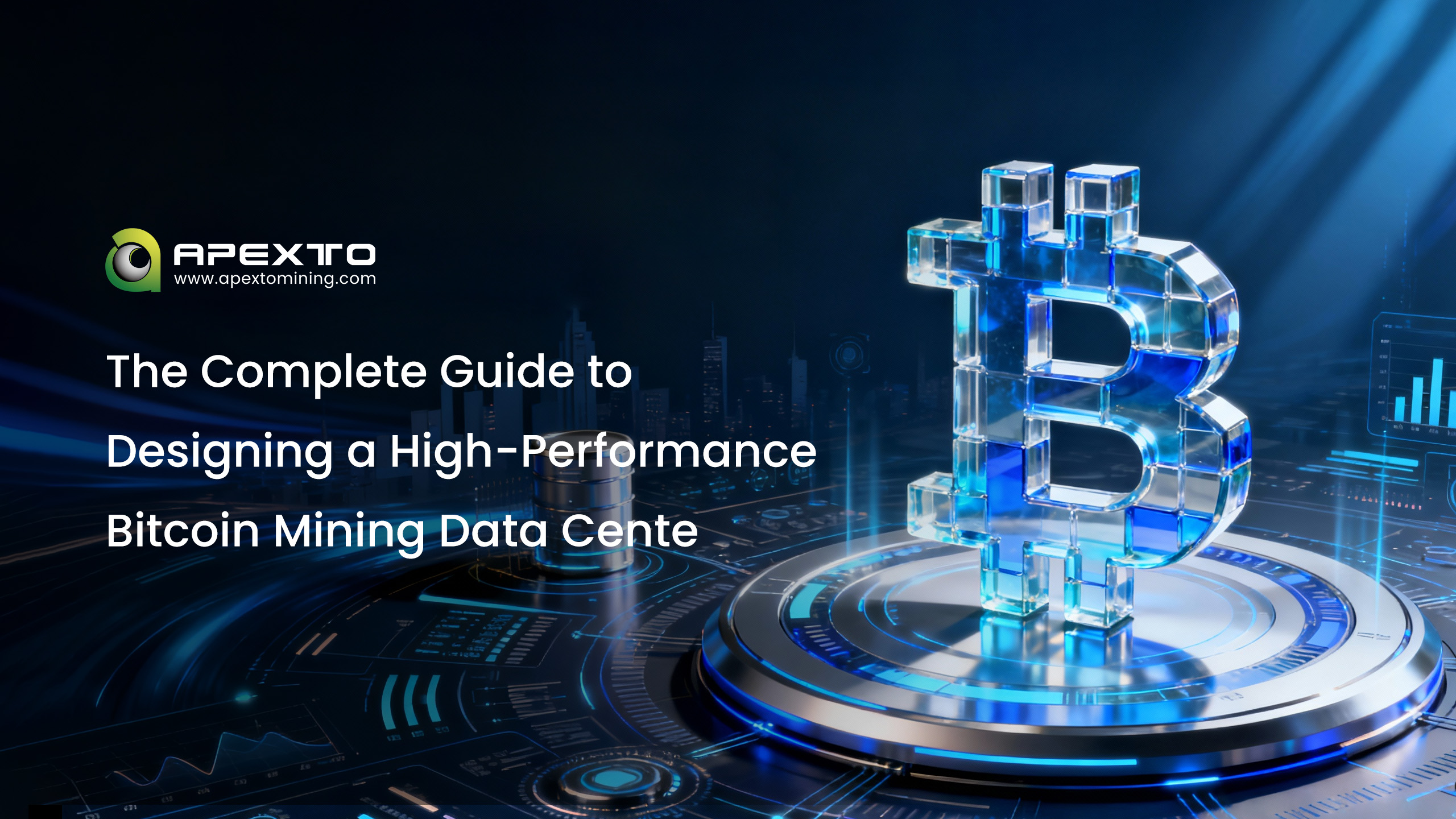The Complete Guide to Designing a High-Performance Bitcoin Mining Data Center

Running a profitable Bitcoin mining operation involves far more than purchasing ASIC miners—it begins with the data center that powers, cools, and protects your equipment.
From the transformers outside your building to the airflow inside each aisle, your facility determines:
-
Uptime and operational stability
-
Performance consistency
-
Hardware safety
-
Energy efficiency
-
Long-term operating costs
This guide breaks down the most important factors to consider when selecting, building, or deploying a mining data center so you can make informed decisions before committing capital.
1. Power Sources: Grid, Renewables, and Hybrid Generation
Electricity is the lifeblood of Bitcoin mining. Your choice of power source directly impacts cost, uptime reliability, and operational risk.
Grid Power
Most mining sites connect to the local grid, but reliability varies widely by region.
Weak or overloaded grids can cause:
-
Voltage drops
-
Unexpected outages
-
Frequent ASIC resets
Choosing regions with industrial-grade electricity infrastructure, stable distribution, and demand-response programs can significantly reduce OPEX.
Some miners reduce energy costs by enrolling in interruptible load programs, trading temporary curtailment capability for lower rates.
Renewable Power
Wind, solar, and hydro sources have become increasingly popular due to:
-
Long-term cost advantages
-
Reduced carbon footprint
-
Alignment with ESG commitments
Many mining companies sign Power Purchase Agreements (PPAs) to lock in predictable energy pricing.
However, renewables introduce variability:
-
Low wind
-
Cloud cover
-
Seasonal hydro changes
This unpredictability can force miners offline unless paired with backup power.
Hybrid Energy Models
To balance cost, stability, and independence, many operators deploy hybrid systems combining:
-
Renewable energy
-
Grid electricity
-
On-site generation (e.g., flared natural gas or gas turbines)
Examples:
-
A Texas farm uses solar during the day, then switches to grid or gas at night.
-
A site near an oil field converts flared gas into stable baseload electricity.
Hybrid systems offer:
-
Higher uptime
-
Energy independence
-
Protection against grid instability
-
Consistent hash rate output
2. Mobile vs. Stationary Data Centers: Which Model Fits Your Strategy?
Your project timeline, land availability, and long-term goals determine the right facility type.
Mobile Data Centers (Containerized Units)
Best for:
-
Rapid deployment
-
Short-term or uncertain land leases
-
On-site power generation (e.g., flare gas)
-
Pilot projects or temporary operations
Benefits:
-
Fast installation
-
Easy relocation
-
Lower upfront infrastructure cost
If your lease lasts only six months or you’re mining at a remote gas-flare site, mobile units allow immediate deployment and relocation when needed.
Stationary Data Centers
Ideal for long-term, high-capacity mining operations.
They typically offer:
-
Higher-density electrical distribution
-
Advanced cooling designs
-
Stronger environmental protection
-
More durable structural materials
Although the initial cost is higher, stationary facilities provide superior:
-
Stability
-
Scalability
-
Long-term maintenance efficiency
3. Efficiency and Environmental Performance: Why PUE Matters
Energy efficiency directly determines mining profitability.
A critical metric is PUE (Power Usage Effectiveness):
-
1.0–1.3 = highly efficient facility
-
>1.5 = significant energy waste in cooling or support systems
Achieving low PUE requires:
-
Optimized airflow and pressure zones
-
Hot/cold aisle containment
-
Blanking panels to block recirculation
-
Proper structural sealing (floors, walls, racks)
-
Prevention of hot air return loops
Benefits include:
-
Lower cooling costs
-
Fewer hardware failures
-
Longer ASIC lifespan
4. Cooling Systems: Protecting Your ASIC Fleet
Heat is one of the greatest threats to mining profitability.
Overheating causes:
-
Frequent shutdowns
-
Reduced hash rate
-
Shortened hardware lifespan
Two main cooling approaches dominate the mining industry:
Air Cooling
A well-designed air-cooled facility requires:
-
High-volume industrial fans
-
Dust-resistant filtration
-
Hot/cold aisle separation
-
Directional airflow channels
-
Temperature sensors at inlet and exhaust points
Air cooling is cost-effective and widely compatible, but demands consistent, well-organized airflow.
Liquid Cooling
Includes immersion cooling and water-cooled mining rigs.
Advantages:
-
Lower noise
-
Superior heat dissipation
-
Higher equipment density
-
Reduced ASIC fan wear
Liquid-cooled containers are ideal for:
-
Hot climates
-
High-density deployments
-
Environments where air control is difficult
5. Construction Quality and Material Standards
Mining facilities operate under harsh conditions—intense heat, heavy electrical loads, airborne dust, and continuous 24/7 operations.
Critical construction components include:
-
Copper wiring with high-grade insulation
-
UL-listed breakers and PDUs
-
Galvanized or cold-rolled steel walls for corrosion resistance
-
Sealed frames to block dust and moisture
High-quality materials reduce downtime, prevent fire hazards, and extend the lifespan of both the facility and the miners inside it.
6. Deployment Speed: Why Lead Time Determines Profitability
A delayed data center often translates into lost revenue, especially when mining difficulty rises or market conditions shift.
Fast deployment requires:
- Prewired electrical architecture
- Preinstalled PDUs and breakers
- Ready-to-run airflow systems
- In-stock replacement parts
Plug-and-play facilities allow miners to rack equipment on day one and begin hashing immediately.
Custom components, on the other hand, can extend lead times by weeks or months — a costly setback in Bitcoin mining cycles.
7. Common Pitfalls to Avoid
Even experienced operators encounter problems that reduce efficiency or uptime. The most common pitfalls include:
Heat Accumulation
Cause: poor airflow design, underpowered fans
Solution: modular airflow zones, thermal monitoring, sealed aisles
Power Trips
Cause: mismatched or low-grade components
Solution: use properly rated UL-listed PDUs and breakers
Dust & Moisture Intrusion
Cause: unsealed enclosures, improper construction materials
Solution: galvanized steel, sealed frames, environmental filtering
Bad Cable Management
Cause: cables blocking airflow and service access
Solution: structured cable trays, airflow pathway planning
8. How Apexto Mining Delivers Better Data Center Solutions
Apexto Mining combines manufacturing, deployment, and real-world mining experience, giving our customers a major advantage.
What Sets Us Apart
✔ In-stock parts — PDUs, fans, breakers, wiring harnesses
✔ Prewired and preconfigured systems for rapid deployment
✔ Modular airflow systems tested in high-temperature environments
✔ Industrial-grade wiring harnesses (mil-spec durability)
✔ Sealed enclosures for dust and moisture protection
✔ Nationwide support teams for on-site assistance
✔ Field-tested designs developed through years of actual mining operations
Because we mine ourselves, we design our data centers to avoid the failures we’ve experienced firsthand — from airflow dead zones to cabling mistakes to weak breaker boxes.
Ready to Build or Deploy Your Next Mining Facility?
If you need help planning, designing, or sourcing your next data center — mobile or stationary — the Apexto Mining engineering team is ready to assist.
We help mining operations of all sizes build efficient, scalable, and deployment-ready facilities that maximize uptime and profitability.
CONCLUSION
A Bitcoin mining data center supports ASIC miners with stable electricity, optimized cooling, and efficient airflow. The best facilities use hybrid power sources such as grid + renewables or flare gas, and maintain a PUE of 1.1–1.3. Mobile containers suit short-term or remote sites, while stationary facilities offer long-term efficiency. Proper cooling—air or liquid—prevents overheating and ensures uptime. Using high-quality materials, UL-certified components, and prewired systems speeds deployment and improves reliability.
FAQs
Should I choose a mobile container or a stationary mining data center?
Choose a stationary center for long-term operations that require higher electrical capacity, advanced cooling, and stronger environmental protection.
What cooling system is best for Bitcoin mining operations?
However, liquid cooling or immersion is better for high-density deployments, hot climates, or sites requiring lower noise and improved heat management.








